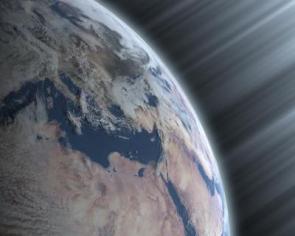 |
| Credit: Danish National Space Center |
Global warming is a very contentious issue. A lot of this is because some people with partisan views have purposely tried to confuse the issue. It’s a fact of life that corporations put a lot of money in some politicians’ pockets, and it’s another fact that a lot of politicians – I’m looking at you, Senator Inhofe (R-19th Century) – have made baldly incorrect statements and have obstructed real debate about the issue.
It’s also a fact that this issue was at first denied by such politicians; they said global warming didn’t exist (Inhofe called it a “hoax”). Under relentless pressure from scientists and other reality-based people, these guys have finally admitted that yes, GW exists. Now, of course, they are trying to lay blame anywhere but on the corporations that pay them so handsomely.
They have looked everywhere to push this blame: solar heating, natural orbital cycles, incomplete data. We can be pretty sure the first is not to blame, and the second is on much longer timescales than the very sudden rise we have been seeing in the past few years/decades. As for the third– well, it’s easy to say “We’re awaiting new data.” But it’s not terribly satisfying.
And now, it looks like another potential natural cause may be going the same way. Fraser Cain, webmaster of Universe Today and blogger for Wired magazine, has an excellent new post up describing how cosmic rays are also not to blame for global warming.
Cosmic rays are subatomic particles (generally protons and helium nuclei) that are moving through space at very near the speed of light. They are almost certainly accelerated to these incredible speeds by shock waves inside of supernovae, exploded stars. These particles scream across space, and many impact the Earth high in the atmosphere. When they do, they pack so much energy that they leave a trail of ionized atoms in their wake; atoms that get stripped of one or more of their electrons.
It has been theorized that water vapor can condense around these trails, aiding low-altitude cloud formation. So when we get more cosmic rays, we get more low-altitude clouds. Clouds reflect sunlight, so the more clouds there are, the cooler it can get. So more CRs means more cooling, and fewer CRs means less cooling, and therefore more warming.
The next part of theory says that periods of warming appear to be correlated with periods of fewer incoming CRs. This fits with the above scenario…
…except, as Fraser’s article points out, scientists have investigated this theory, and found it to be very unlikely, to say the least.
First, there doesn’t appear to be any correlation with incoming cosmic rays and middle to high-altitude cloud formation, even though the ionizing effects of CRs are greater at those greater heights. In other words, you’d expect to see more clouds at all altitudes, not just low altitudes. That’s not the case.
Second, it’s not clear that CR ionization trails really can make clouds. The scientists found the ionization rate to be too low to explain the amount of clouds seen.
Third, CRs are channeled to the north and south poles by the Earth’s magnetic field, so you’d expect to see the strongest correlation there. We don’t, and in fact the trend is opposite what’s expected!
And there’s more; go read Fraser’s article for the low down.
Bottom line: cosmic rays are not a very good excuse for global warming as yet. I hate to sound like Inhofe, but we do need to look into this more to understand the situation; it’s fiendishly complicated. But a simple look at the data and claims seems to indicate that if you’re looking for some cause of global warming other than man, then you’d better keep looking. The hidey holes are getting smaller every day.